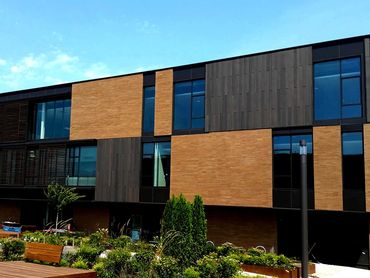A Proud Distributor of RESYSTA

-bf3ff1d.jpeg/:/cr=t:16.62%25,l:0%25,w:100%25,h:66.77%25/rs=w:370,h:278.1954887218045,cg:true)
Quality Materials
Resysta is one material with unlimited possibilities. Better than wood. This impressive LEED attainable product offers environmentally responsible options with durability, and style. Resistance to climatically challenging conditions make this the ideal material for exterior envelope and deck applications, as well as creative interiors such as walls and flooring in kitchens and bathrooms.
100% no wood
Many Profiles to suit your needs
Color Stability.
Many colors of durable, environmentally friendly, water-based RCL stain/sealer [coordinating color information]
Resysta Artistry colors available in the same environmentally friendly RCL products
Custom Aluminum Trim available
Slip Resistance: Class C (highest class)
Brinell Hardness (HB) : 11.762 psi (EN 1534)
Water based RBP Primer
Density: Approximately 1,46 g/cm3
Little to no water absorption
Durability: against fungi and molds—Class 1 (highest class)
Dirt/ stain repellent
Closed Surface
Low maintenance
Limited Manufacturer’s Warranty at Resysta
Beautiful like natural wood
The proprietary water-based formula is odorless, with minimal maintenance—easily cleaned with gentle detergent and water. Resysta material is infused with natural rice hull fibers, so each board captures color shades with beautiful grain variations. These distinctions from one plank to another give Resysta a natural wood-like appearance—consistently inconsistent. No other man made composite product has properties like RESYSTA.
Wood vs Resysta
For many years siding has been the most traditional form of decorating and waterproofing building walls. Currently the building industry offers several options for this product, but still the most popular remain wood and plastic.
Although visually there are many positive aspects of using siding, every one of them has its disadvantages. Installation of widely preferred wooden siding is followed by costly maintenance that needs to be performed every 4 to 9 years and the plastic siding presents a high environmental cost related to difficulty of responsible disposal.
Therefore fully recyclable Resysta siding is a perfect solution. With the natural look and feel of wood followed by the minimal maintenance requirements it won over the architects, homeowners and contractors all over the USA.
RAINSCREEN AND VENTILATION
A rainscreen system is a type of building envelope that is designed to protect a building from water infiltration. It consists of a layer of siding or cladding that is installed over a layer of insulation and a moisture barrier, with a space (called the “rainscreen”) between them to allow for ventilation and drainage.
One of the main reasons that rainscreen systems need ventilation is to prevent moisture from becoming trapped within the walls of the building. When moisture is allowed to accumulate within a wall cavity, it can lead to a variety of problems, including rot, mold, and structural damage. By providing a way for moisture to escape, a rainscreen system helps to keep the building dry and healthy.
In addition to preventing moisture damage, ventilation can also help to regulate the temperature and humidity within the building envelope. By allowing air to circulate through the rainscreen, the temperature and humidity levels within the walls can be kept at a more consistent and comfortable level, which can help to improve indoor air quality and comfort.
Finally, ventilation is an important consideration when designing a rainscreen system because it can affect the overall energy efficiency of the building. By allowing air to circulate through the rainscreen, a building can take advantage of natural ventilation and reduce the need for mechanical heating and cooling systems. This can help to reduce energy consumption and operating costs, making the building more sustainable and cost-effective to operate.
In summary, ventilation is an essential component of a rainscreen system because it helps to prevent moisture damage, regulate temperature and humidity, and improve the energy efficiency of the building. By designing a rainscreen system that allows for proper ventilation, building designers and owners can help to ensure the long-term durability and performance of their buildings.
